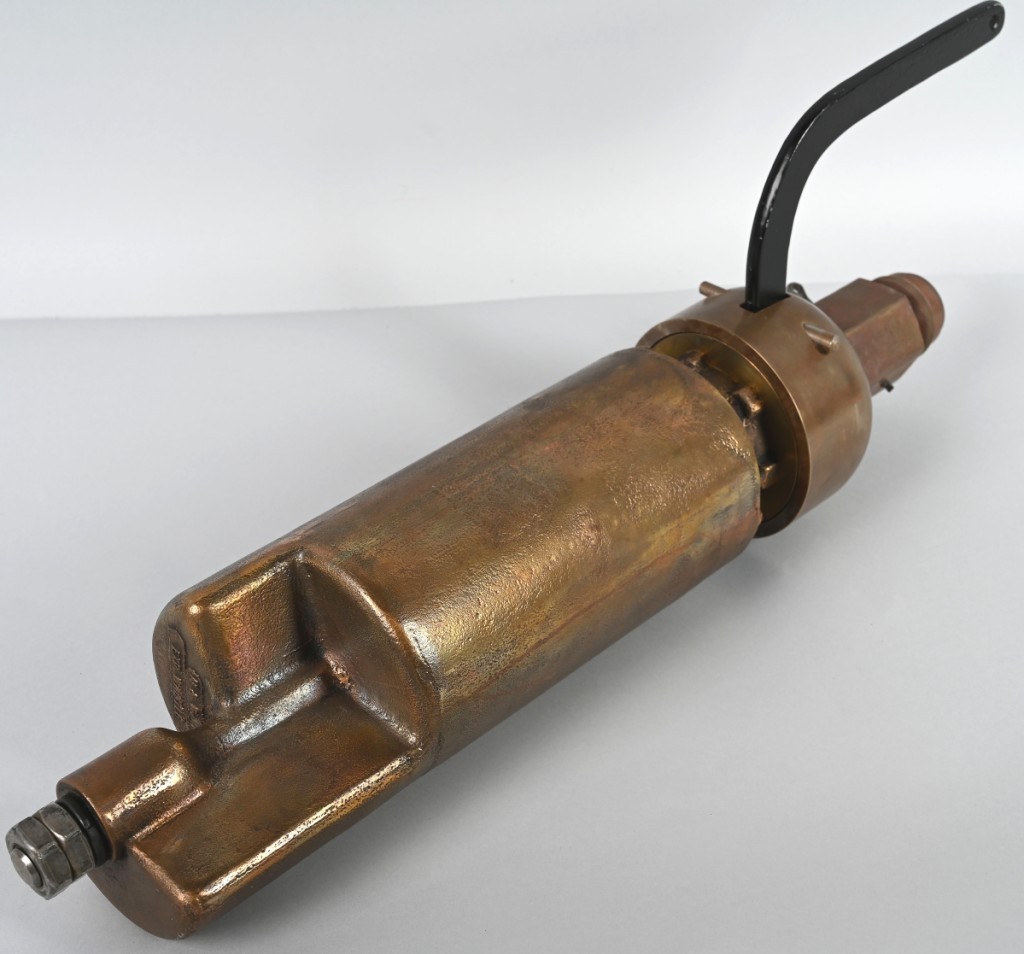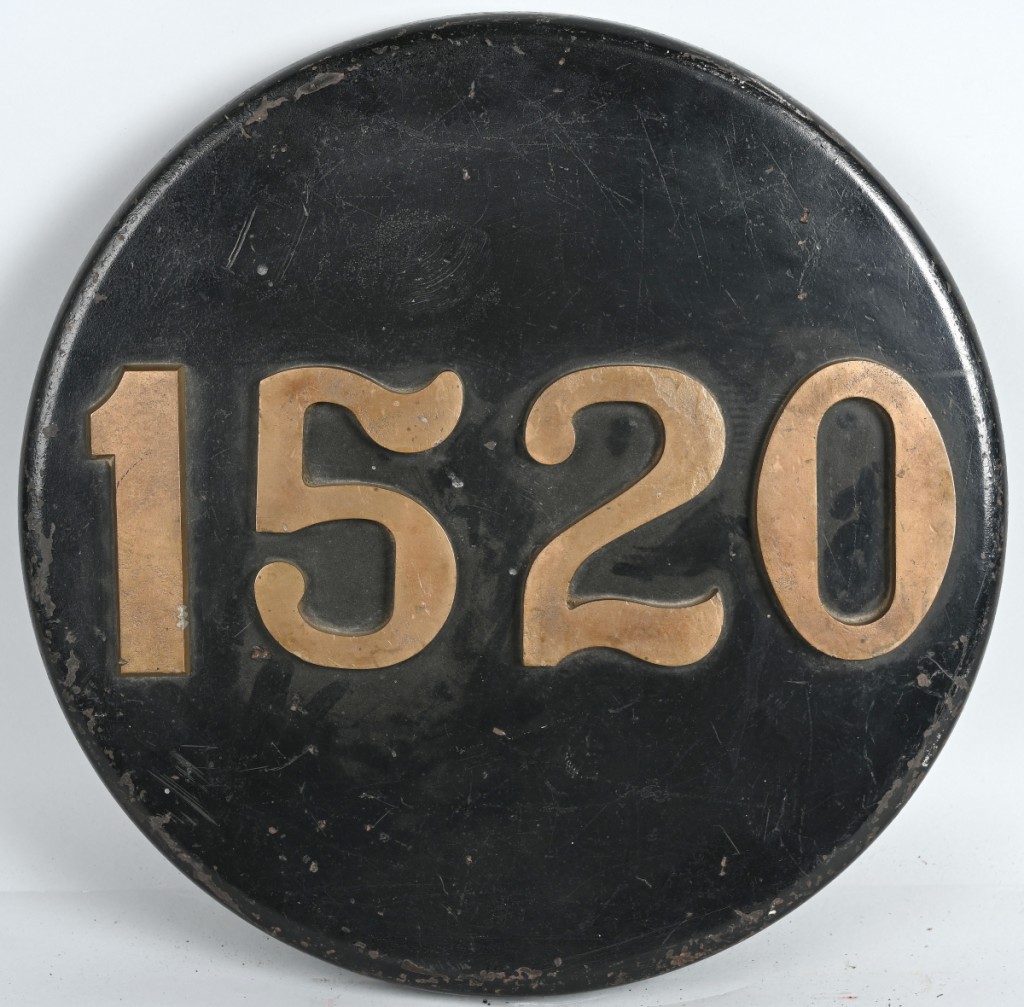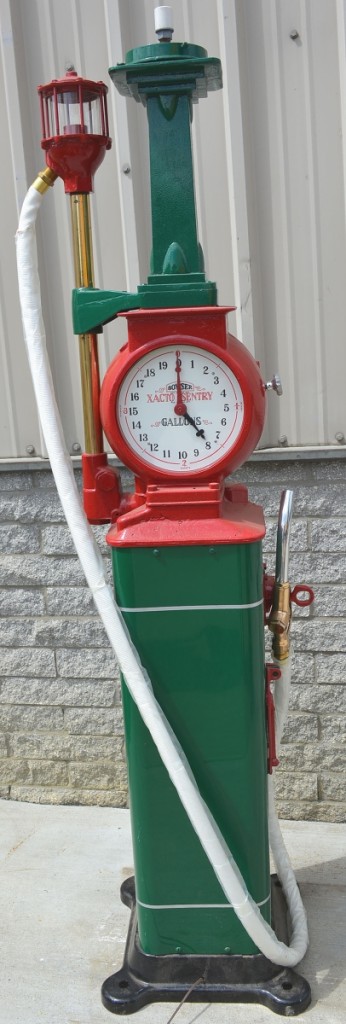
Top lot in the sale was this large (27 inches) and rare three-chime brass train whistle, marked “N&W Exp.,” which finished at $11,100.
Review by W.A. Demers, Photos Courtesy Milestone Auctions
WILLOUGHBY, OHIO – On August 29 Milestone Auctions’ gallery was transformed into a virtual train depot for the display and live auction of Brian Maiher’s estate collection of railroadiana, fire-related antiques and petroliana. The 676-lot auction devoted exclusively to the Maiher holdings was a testament to the late dealer/collector’s discerning eye and unwavering 40-year commitment to preserving Nineteenth and early Twentieth Century American railroad relics. Renowned in train, fire and petroliana collecting circles, the Maiher collection was amassed from decades of attending shows and networking within the hobby and was displayed inside and on the grounds of the Maihers’ spacious Ohio residence.
Top lot in the sale was a large (27 inches) three-chime brass train whistle, marked “N&W Exp.,” which finished at $11,100. One of only six known examples, it now enters another private collection.
“It was a phenomenal sale,” said co-owner Miles King of the auction that totaled $816,000. “All the bidders came out for this one.”
“By profession, Brian and his wife Jill were partners in a very successful demolition and salvage company that was started with just one dump truck and small bulldozer,” said Chris Sammet, co-owner. “For many years Brian did wrecking work for railroads, taking down train stations, roundhouses and other structures. Fortunately, he saw treasure where others saw trash, and often he would rescue the relics he had been paid to destroy. In fact, the bricks, trusses and lumber used to build his and Jill’s home came almost entirely from demolished buildings. That was the beginning of what would become a phenomenal collection containing many one-of-a-kind objects.”

A Reading Railroad #1520, 2-8-0 camel back engine number plate from 1905 jumped its $400/700 estimate to finish $8,700.
In addition to locomotive whistles, as well as dozens of railroad lanterns, there were many other train-related objects of interest. A Reading Railroad #1520, 2-8-0 camel back engine number plate from 1905 jumped its $400/700 estimate to finish at $8,700. In very good condition with a 20-inch diameter, the heavy cast iron rolled edge plate featured bolt-on brass numbers and a mounting stem with the numbers A15407 stamped in back.
What may have been a Pennsylvania Railroad station sign, “Bird In Hand,” realized $8,400. The heavy, single-sided cast iron sign, 17 by 74 inches and marked M-72 on the back, had been repainted.
Fetching $7,200, more than triple its high estimate, was a single-sided diecut cast iron Pennsylvania Railroad “Leetsdale” station sign. It, too, had been repainted. Marked 53864 on the back, it measured 24 by 47 inches.
Every aspect of railroad culture could be found in the Maiher collection. Take, for example, the rare drum heads that were typically seen on North American trains during the first half of the Twentieth Century. These removable signs with interior illumination were mounted to the rears of passenger trains and showed the name of either the railroad or specific train. Great Northern Railway, with trademark imagery of its mountain goat mascot “Rocky,” was represented by a drum head that went out at $6,900.

Leading a group of professionally restored gas pumps was this Bowser “Pumpkin Head” clock face gas pump with spinner gauge, new white hose and brass nozzle. It elicited a winning bid of $8,400.
Maiher did not collect just railroadiana. Another collecting category that captured his imagination was petroliana. He amassed an array of gas pumps and globes, signs, service station display racks – preferably with their original motor oil bottles or cans – and other related items. Leading these items was a Bowser “Pumpkin Head” clock face gas pump, which had been professionally restored. With spinner gauge, new white hose and brass nozzle, it elicited a winning bid of $8,400.
Among other top pumps were a National Simplex clock face gas pump and a Tokheim Victory 5-gallon visible gas pump professionally restored in Shell Gas colors with repro globe, each selling for $7,200, as well as a Penometer clock-face gas pump restored in Sohio colors with a reproduction globe and new white hose and brass nozzle that made $6,900.
After Brian had acquired everything he ever wanted in the railroad and petroliana categories, he became interested in fire alarms, buying antique productions from as early as the 1860s and through to the present day. Of the 40 or so alarms offered in the sale, Sammet said, “Some of them are really great looking, especially the early ones with gongs and unusual shapes. They’re both mechanical and decorative. There are also some old cast iron ones from the 1910s-20s that came from either firehouses or buildings that were alarmed for safety.” A prime example was a 32-inch-long Gamewell Excelsior transmitter with 50 code wheels, in a refinished flat top oak case and beveled glass front door, which beat its $4,000 high estimate to pull in $7,800.
Prices given include the buyer’s premium as stated by the auction house. For information, www.milestoneauctions.com or 440-527-8060.














